(click on photos to enlarge)
BURIED TREASURES
Burying the silver to prevent an enemy' robbery is an ancient
practice, still surviving in recent times.
Between 1996 and
1998 the so-called Moritzburg Treasure was found in the
forest near the Castle of Moritzburg where it was buried before
the Russian Army's occupation of the German town of Dresden.
The 'Treasure' consists of some hundreds of jewelry and silverware
pieces belonging to the heirs of the Royal House of Saxony.
|
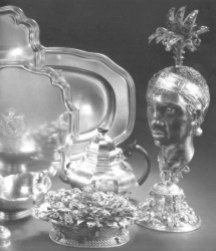 |
| |
The Moritzburg Treasure
with Moor's head cup and
Basket of Flowers
|
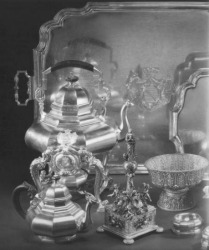 |
Among the
pieces found in the forest were the 'Moor's Head Cup'
made by Christoph Jamnitzer in 1615 and the jewelled and enamelled
gold and silver 'Basket of Flowers' presented by Johann
Melchior Dinglinger to Augustus the Strong in Warsaw at Christmas
1701.
Notwithstanding, only three of 43 boxes buried in 1945 were
recovered from the Royal Wettin House heirs as the others were
located and removed in 1947, during the Russian occupation of
Germany. |
The Moritzburg Treasure
|
|
Far more unfortunate were the owners of other treasures buried during the time
of the ancient Roman Empire. They never recovered their assets and,
fully unintentionally, allowed their precious silverware pieces made over
1500 years ago to survive intact until our days:
The Treasure of Seuso and the Treasure of Kaiseraugust.
The Treasure of Seuso
There is no
certainty on the origin of this treasure, although it is thought that
it was found in Lebanon about 1970. Another, and more probable hypothesis, is that its origin
was Pannoniae (Hungary), as the only geographic indication found on the treasure is the name
of the lake 'Pelso', which is the Latin name of the lake Balaton that is situated in West
Hungary. The pieces, all made
between the 4th and the 5th century after Christ, were packed into a
large bronze pail dating to the 6th or 7th century after Christ which
preserved the content from oxidation and maintained the silver in
perfect condition. The most plausible hypothesis is that the
treasure was buried in the 7th century, at the time of the Arabic
conquests.
|
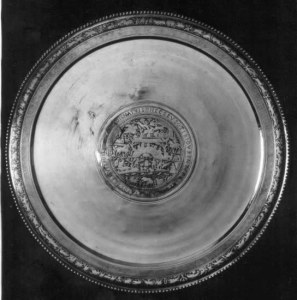 |
| |
Dish with central medallion with Seuso dedication
|
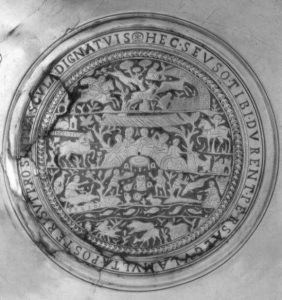 |
The treasure
derives its 'Seuso' name from the Latin inscription on the central
medallion of a large dish that allows us to identify the owner ('That
these small containers, oh Seuso, belong to you and your descendants for many centuries and
prove worthy of them' 'HEC SEUSO TIBI DURENT PER SAECULA
FINES POSTERIS UT PROSENT VASCULA DIGNA TUIS').
The central medallion has a niello decoration representing
hunting and the banquet of Seuso. Other hunting scenes are on the
edge (the diameter is 27 3/4 in.). |
The central medallion with Seuso dedication
|
|
The treasure is constituted comprehensively of 14 silver objects and,
besides the dish of Seuso, includes:
- another four dishes of differing size,
- five pitchers of varied measure with vertical handle, embossed and
nielloed,
- an ewer embossed with a Dionysiac procession,
- two 'situle' (note 1) embossed with scenes of the myth
of Hippolyte and Phèdre,
- A cylindrical container with conical cover embossed with scenes of a
lady's toilet
|
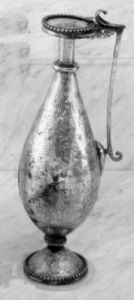
|
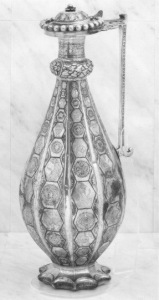
|
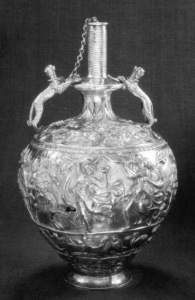
|
pitcher with geometrical
and floral engravings,
22 in. high (a pair)
|
pitcher with 120 hexagonal panels engraved and nielloed with
human and animal figures and geometrical motifs
(20 in. high)
|
silver gilt ewer with embossing of a Dionysiac procession and
handles in the shape of two panthers (15 1/4 in. high)
|
|
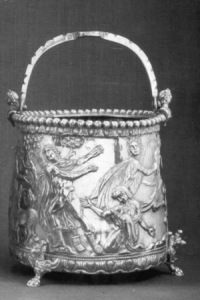
|
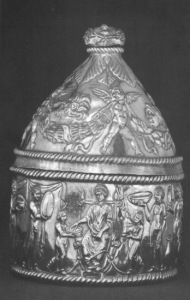
|
situla (note 1) embossed with
scenes of the myth of Hippolyte and
Phèdre, 11 1/2 in. high (a pair))
|
cylindrical container with conical
cover embossed with scenes of a
lady's toilet (12 1/2 in. high)
|
|
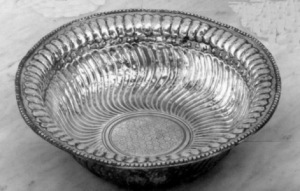
|
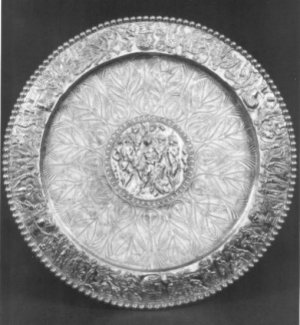
|
dish with waves and geometrical motifs
(18 in. diameter)
|
'dish of Meleagro' decorated with
Calidone's wild boar hunting scenes
(28 in. diameter)
|
The Treasure of Kaiseraugust
The provenance of the Kaiseraugust's Treasure is well known, but the
circumstances of its finding are absolutely astonishing.</p>
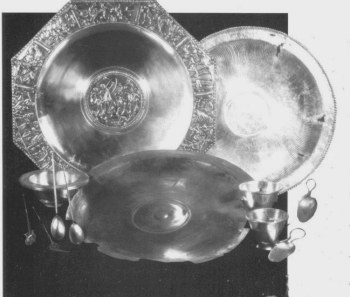 |
In February
of 1962 the archeological authority of Augst (Switzerland) received
the report of the finding of silverware pieces inside the
ancient Roman military installation (castrum) of Kaiseraugust.
The objects were brought to light by a mechanical shovel excavating
the foundations of a building at the inside of the ancient
'castrum', but no one realized that precious archeological silver
items had been discovered.
|
The Kaiseraugust's treasure (part)
|
|
The objects
remained at the excavation site, were covered by the snow, and
only after a month the inhabitants of the area, fully unaware of
the importance of the finding, proceeded to recover and to preserve,
just for an idle curiosity, some pieces brought up from the excavation.
After patient research at the site, within the excavation
materials and retrieved from the inhabitants of the area (for some
the objects were only 'old pans for sweets'), 257 silver pieces were
recovered, comprising 187 coins and medals, for a total weight of
almost 1300 oz. (37 kg) of silver.
|
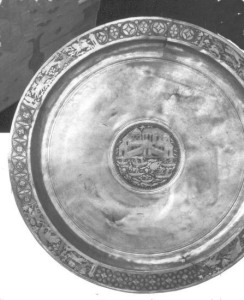 |
| |
dish with central medallion
representing a harbour
(diam. 23 1/4 in.)
|
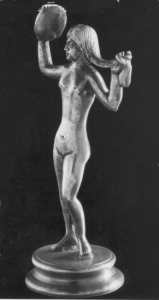 |
The finding was
done near the walls of the 'castrum' of the ancient Roman town of
Augusta Raurica, established in the age of Emperor August on the Rhine
river shore, along the northern border of the Roman Empire.
After the initial period of prosperity supported by its favourable
geographic location, the town, which eventually had 15,000
inhabitants, suffered heavily due to the precariousness of its border
position under the pressure of the barbaric populations of the
Alemannic tribes and was entirely abandoned at the end of the 4th century
A.D.
The 1st Legio 'Martia' was charged with the protection of the Rhine border by
the Emperor Diocletian. The military headquarter was established in
the Castrum Rauracense in the 'old town' and near the bridge
crossing the river Rhine.
|
small statue of Venus looking at the mirror
(4 1/2 in. high)
|
|
The treasure was
buried in about 350 A.D., a period characterized by hard struggles
between the sons of Emperor Constantine (Flavius Valerius
Constantinus or Constantine the Great) and the usurper Magnetius
(this date was achieved studying the coins contained in the
treasure).
Many of these pieces are roughly inscribed with the names of their
owners (Marcellianus and P. Romulus) or with the signature and
the town of origin of the craftsman, Euticius of Naissus (note 2)
and Pausylypos of Thessalonica (note 3).
|
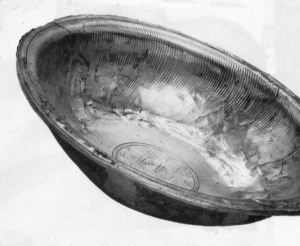 |
| |
dish with a star on the centre
(diam. 16 1/2 in.)
|
The main part of the treasure consists of by silver tableware of
various shapes, spoons (with long handle and with short handle ending in
a ring), smooth or embossed basins, candlesticks, richly decorated
dishes, a small statue of Venus and numerous coins kept in rolls.
|
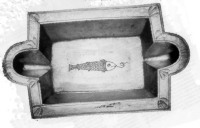
|
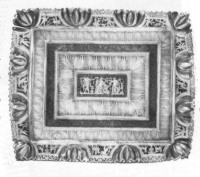
|
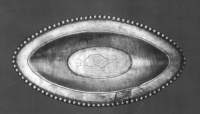
|
dish with fish decoration
(10 1/2 in. long)
|
tray with central insert with Ariadne between Dionysus and a
satyr (16 1/2 in. long)
|
small dish with a fish
|
Endnotes
(1) The Latin word 'situla' conventionally identifies a pot of
conic or ovoidal shape. Its specific function was to get and to contain
liquid. The pictures of some Etruscan pots and of the ceramics show its
use as a bucket to get the water from the well, like container of sacred
water in religious ceremonies, like a pot for libations or for collecting
the blood of the victims during the sacrifices or the bacchical rites.
Typical of 2nd and 3rd century A.D. are the silver 'situla' with deep
domed bowl copied by similar items made in bronze by Gallic and German
populations.
(2) Nis, in Yugoslavia (now Serbia)
(3) Thessalonica, in Macedonya (Greece)
|



















